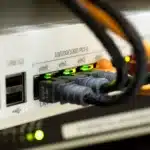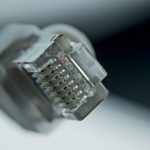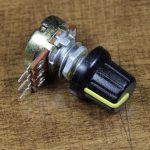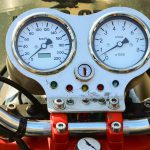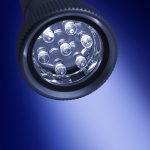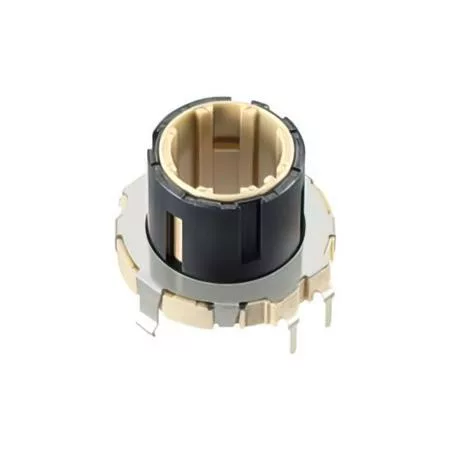
Introduction
Panel-mount encoders are significant components in multiple industrial applications–providing precise and reliable feedback for controlling processes and machinery. These devices play a pivotal role in automation, robotics, CNC machining, and other industries where accurate position and speed control are paramount. This article elucidates the key concepts and functions of panel-mount encoders, shedding light on their importance and applications.
Understanding Panel-Mount Encoders
Panel-mount encoders, also called control knobs or rotary encoders, are electromechanical devices designed to convert mechanical (angular) motion into electrical signals. They are commonly used to measure the position, speed, or rotational direction of a shaft or other moving components and provide feedback to a control system. Panel-mount encoders are mounted on control panels or machinery, hence the name “panel-mount”–and are used in conjunction with motors, drives, and controllers to provide feedback and enable precise control.
Basic Components of Panel-Mount Encoders
Understanding the basic components of a panel-mount encoder is essential to grasp its full functionality. A typical panel-mount encoder consists of the following key elements:
- Shaft: The shaft is the part of the encoder that connects to the moving component whose position or rotation needs to be monitored. It can be a motor shaft, conveyor belt roller, or any other rotating element.
- Encoder Disk: The encoder disk is mounted on the shaft and typically contains a series of slots or lines arranged in a circular pattern. As the shaft rotates, these slots or lines pass through an optical or magnetic sensor, generating electrical signals.
- Sensor: The sensor – the heart of the encoder, is responsible for detecting the slots or lines on the encoder disk. Optical and magnetic sensors are the two most common types used in panel-mount encoders. Optical sensors utilise light to detect changes in the encoder disk, while magnetic sensors rely on changes in magnetic fields.
- Electronics: The electronics in the encoder process the signals generated by the sensor. They may include amplifiers, signal conditioning circuits, and output circuits. The output signals are typically in the form of electrical pulses, which can be further processed and interpreted by controllers or computer systems.
Key Concepts in Panel-Mount Encoders: Precision in Panel-Mounting
To understand panel-mount encoders better, it’s essential to familiarise yourself with some key concepts associated with bespoke electromechanical devices, including:
Resolution
Resolution refers to the encoder’s smallest incremental detected and reported movement–typically measured in pulses per revolution (PPR) or lines per millimetre (L/mm). Higher resolution encoders provide finer position feedback.
Output Types
Panel-mount encoders can output various signal types, including:
Analog Voltage
Produces a continuous voltage proportional to the position.
Digital
Outputs digital pulses, typically in the form of quadrature signals (A and B channels), to determine both position and direction.
Serial Communication
Some encoders communicate position data digitally using protocols like RS-485 or Ethernet.
Mechanical Configuration
Panel-mount encoders come in various mechanical configurations based on the specific application and the measuring motion.
Mounting Styles
Encoders can be mounted on panels, control panels, or equipment surfaces in various ways, depending on the specific application needs. The most common mounting styles of panel-mount encoders include flange mount, base mount, PCB mount, clamp mount, servo mount, rear mount, surface mount, DIN rail mount, and magnetic mount encoders.
Popular Types of Panel-Mount Encoders: Exploring Their Broad Range Varieties
Panel-mount encoders come in various types, each suited to specific applications and requirements. Some of the most common panel-mount encoder types include:
Rotary Encoders
Rotary encoders are designed for rotational motion and are used to measure angles or positions. They are commonly used in applications like robotics and conveyor systems, where knowing the precise angle of rotation is crucial.
Incremental Rotary Encoders
Incremental encoders generate pulses or counts as the shaft rotates. They provide information about the direction of rotation and the number of counts, allowing for precise position and speed control. However, they do not provide absolute position information, meaning they must be initialised to a known reference point during startup.
Absolute Rotary Encoders
Absolute encoders provide a unique code or value for each possible shaft position. This allows them to determine the exact position of the shaft without requiring initialisation. They are ideal for applications where position accuracy is critical, such as robotics and CNC machining.
Linear Encoders
Linear encoders are designed for linear motion and measure the position of a linearly moving object. They are frequently used in CNC machine tools and other equipment that require precise linear positioning. Like rotary encoder types, linear encoders come in incremental linear encoders and absolute linear encoders.
Optical Encoders
Optical encoders use light-based technology, typically an LED and a photosensitive sensor, to generate position feedback. They are known for their high resolution and accuracy.
Magnetic Encoders
Magnetic encoders use magnetism and Hall-effect sensors to determine position. They are often used in environments with dust, dirt, or other contaminants since they are more robust than optical encoders.
Digital Encoders
Digital encoders produce digital signals, often in the form of binary code or grey code, to represent position changes. They are widely used in digital control systems.
Analog Encoders
Analog encoders produce a continuous analog voltage or current output that corresponds to the shaft’s position or speed. These encoders are used in applications where precise analog control is necessary, such as in audio equipment and servomechanisms.
Fundamental Functions of Panel-Mount Encoders
Panel-mount encoders serve several critical functions in industrial applications, including:
Position Feedback
One of the primary functions of panel-mount encoders is to provide real-time position feedback. This information is essential for ensuring that machinery and processes are operating as intended. It enables controllers to adjust and make corrections to maintain accuracy and consistency.
Speed Control
By measuring the rate of change in position, panel-mount encoders allow for precise speed control. This is crucial in applications where maintaining a specific speed is essential, such as in conveyor systems and motor control.
Direction Detection
Many encoders can detect the direction of rotation or movement. This information is valuable for ensuring that machinery operates correctly and for preventing damage that could occur due to unexpected changes in direction.
Error Detection
Panel-mount encoders can be used to detect errors or anomalies in the system. If the encoder signals deviate from the expected values, it can trigger alarms or shutdown procedures, preventing potential damage or hazards.
Position Memory
Absolute encoders, in particular, provide position memory, allowing machinery to resume operations accurately after a power interruption or emergency stop. This is critical in applications where maintaining precise positioning is essential.
Bottom Lines
Panel-mount encoders are indispensable components in industrial automation and control systems–providing accurate position and speed feedback. These electromechanical devices are known for their precise control of machinery and processes across various industries. Therefore, understanding the basic components, key concepts, and functions of panel-mount encoders is essential for engineers and professionals working in their fields.












